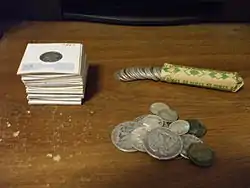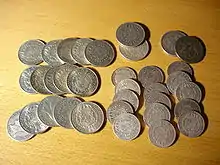Junk silver
Junk silver is an informal term used in the United States, United Kingdom, Canada and Australia for any silver coin that is in fair or cull condition and has no numismatic or collectible value above the bullion value of the silver it contains. Such coins are popular among people seeking to invest in silver, particularly in small amounts. The word "junk" refers only to the value of the coins as collectibles and not to the actual condition of the coins; junk silver is not necessarily scrap silver.[1]

Precious metals including silver are measured in troy ounces (ozt). A spot price for silver is the price for a troy ounce of silver which is 99.9-percent pure, or 999 fine. Silver coins including junk-silver coins have set silver-alloy contents ranging from 35-percent to 90-percent or more. The term "coin silver," for example, refers to 90-percent silver alloy which was the most common alloy used to mint silver U.S. coins.
Any combination of 90-percent silver U.S. coins which have a face value of US$1.00 contains 0.715 troy ounces (22.2 g) of 99.9-percent silver[2] (0.7234 troy ounces if uncirculated), except for the silver dollars (Morgan and Peace) which contain 0.7736 troy ounces (24.06 g) troy ounces of silver. In other words, one troy ounce (31 g) of 99.9-percent silver is contained in any combination of 90-percent silver U.S. coins which have a face value of US$1.40.[3]
Common U.S. coins
The most commonly collected junk-silver U.S. coins were minted before 1965 and include Morgan and Peace dollars; Liberty Head "Barber," Walking Liberty, Franklin and Kennedy half dollars; Liberty Head "Barber," Standing Liberty and Washington quarters; Liberty Head "Barber," Winged Liberty Head "Mercury" and Roosevelt dimes; and Jefferson "Wartime" nickels.[4]
Dollars
Half-Dollars
- Liberty Head "Barber" (1892–1916) -- 90-percent silver
- Walking Liberty (1916–1947) -- 90-percent silver
- Franklin (1948–1963) -- 90-percent silver
- Kennedy (1964) -- 90-percent silver
- Kennedy (1965–1970) -- 40-percent silver
Quarters
- Liberty Head "Barber" (1892–1916) -- 90-percent silver
- Standing Liberty (1916–1930) -- 90-percent silver
- Washington (1932, 1934–1964) -- 90-percent silver
Dimes
- Liberty Head "Barber" (1892–1916) -- 90-percent silver
- Winged Liberty Head "Mercury" (1916–1945) -- 90-percent silver
- Roosevelt (1946–1964) -- 90-percent silver
Nickels
- Jefferson "Wartime" (1942 (partial)-1945) -- 35-percent silver
Common U.K. coins
The most commonly collected junk-silver U.K. coins were minted before 1946 and include Edward VII, George V and George VI crowns; as well as Victoria, Edward VII, George V and George VI half crowns, florins, shillings, six pences, and three pences.[4]
Crowns
- Victoria(2nd & 3rd portraits) (1887-1900) -- 92.5-percent silver
- Edward VII (1902) -- 92.5-percent silver
- George V (1927–1936) -- 50-percent silver
- George VI (1937) -- 50-percent silver
Half Crowns
- Victoria (1837–1901) -- 92.5-percent silver
- Edward VII (1902–1910) -- 92.5-percent silver
- George V (1911–1919) -- 92.5-percent silver
- George V (1920–1936) -- 50-percent silver
- George VI (1937–1946) -- 50-percent silver
Florins (2 Shillings)
- Victoria (1849–1901) -- 92.5-percent silver
- Edward VII (1902–1910) -- 92.5-percent silver
- George V (1911–1919) -- 92.5-percent silver
- George V (1920–1936) -- 50-percent silver
- George VI (1937–1946) -- 50-percent silver
Shillings
- Victoria (1838–1901) -- 92.5-percent silver
- Edward VII (1902–1910) -- 92.5-percent silver
- George V (1911–1919) -- 92.5-percent silver
- George V (1920–1936) -- 50-percent silver
- George VI (1937–1946) -- 50-percent silver
Six Pences
- Victoria (1837–1901) -- 92.5-percent silver
- Edward VII (1902–1910) -- 92.5-percent silver
- George V (1911–1919) -- 92.5-percent silver
- George V (1920–1936) -- 50-percent silver
- George VI (1937–1946) -- 50-percent silver
Three Pences
- Victoria (1838–1901) -- 92.5-percent silver
- Edward VII (1902–1910) -- 92.5-percent silver
- George V (1911–1919) -- 92.5-percent silver
- George V (1920–1936) -- 50-percent silver
- George VI (1937–1945) -- 50-percent silver
Other countries

Canadian dollar, half-dollar, quarter and dime coins minted after 1919 and before 1967 contained 80-percent silver. Those minted 1919 or earlier are sterling (92.5%) silver.[5] For these coins (1920 - 1966), every CAD$1.00 in face value contains 0.6 troy ounces (19 g) of silver. The 1967 quarter and dime were minted in either 80% or 50% silver. The 50% quarters and dimes continued part way through 1968 until the mint introduced the 100-percent nickel versions of all the coins mentioned beforehand. To tell the 1968 nickel and silver coins apart, the ones made from nickel are magnetic whereas the silver coins are not.
Australian pre-decimal florin, shilling, sixpence and threepence coins minted from 1910 to 1945 contained 92.5-percent silver. From 1946 to 1964, they were minted in "post-silver" coins which contained 50-percent silver. In 1966, the "round" 50-cent coin contained 80-percent silver.[6]
Swiss 1/2 Franken, 1 Franken and 2 Franken minted from 1874 to 1967 contained 83.5 percent silver. 5 Franken minted from 1922 to 1928 contained 90-percent silver and weighed 25 grams (0.80 ozt), and those minted between 1931-1969 contained 83.5 percent silver and weighed 15 grams (0.48 ozt).
Mexico and many other Central American countries made silver coins that are considered junk silver today.
Popularity
Junk-silver coins may be a desirable method of investing in silver for several reasons:
- Low premiums
- Coins can often be purchased for little or no premium over the spot price of silver, particularly during periods of economic stability.
- Legal tender
- In many cases, coins remain legal tender (one notable exception being the United Kingdom, where pre-decimal coinage - including examples minted in silver - was demonetised after the move to decimalisation) and maintain their face value regardless of the price of silver.
- Recognition
- Coins are familiar and less likely to have their value disputed than silver rounds or bars.
- Divisibility
- Coins can be easily spent or traded in small amounts. In contrast, minted silver bullion is rarely smaller than a troy ounce, while minted gold bullion (and other precious metals) is highly valued in even small amounts, like the American Gold Eagle coins.
For these reasons, junk silver is popular among survivalists. In the event of a crisis or catastrophe during which traditional currency collapses, it is speculated that silver coins could provide a viable alternative, temporarily or indefinitely, while fiat currency, which is not backed by precious metals or other commodities, has no inherent value and can be subject to extreme inflation, even hyperinflation, similar to Weimar Germany, post-WWII Hungary and, more recently, Zimbabwe's dollar and Venezuela's bolivar fuerte. Proponents of junk silver and other precious metals claim that, while fiat currencies have historically been subject to hyperinflation, precious metals will always have inherent value and can act as a medium of financial exchange when fiat currencies are obsolete.
Junk copper
Some coin collectors and investors are also informally using the term "junk copper" to refer to any copper-bullion coins of no numismatic value.[7] Prominent examples include U.S. pennies minted before 1982 (partial), Canadian pennies minted before 1997, and some pre-euro copper European coins. 154 junk-copper U.S. pennies contain a full pound of .950 fine copper.
See also
References
- This citation provides no clarification distinguishing the term junk silver from the equally ambiguous term scrap silver. "90% Silver U.S. Coin Bags". Monex. Newport Beach, Calif.: Monex Precious Metals. Retrieved 2009-07-31.
- "1964 D Washington Quarter".
- "U.S. Silver Coin Melt Value Calculator". Coinflation.com. Unknown: Coinflation.com. Retrieved 2009-08-07.
- "Spot Prices for Silver Bars, Silver Coins and Silver Rounds". Bullion Spot Price. Unknown: BullionSpotPrice.com. Retrieved 2009-08-10.
- "Coin Melt Calculator". Metallicoin.com. United States: Metallicoin.com. Archived from the original on August 8, 2014. Retrieved 2013-05-07.CS1 maint: unfit URL (link)
- "Handy calculators for Australian silver coins". Silver Stackers Forum. Australia: silverstackers.com. Archived from the original on 2009-09-03. Retrieved 2009-08-29.
- "Junk Copper Coins".
